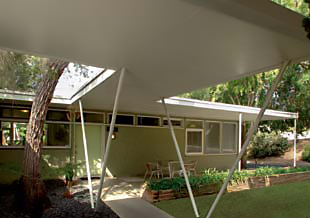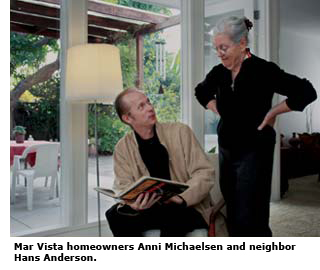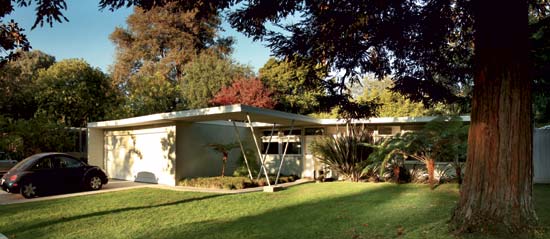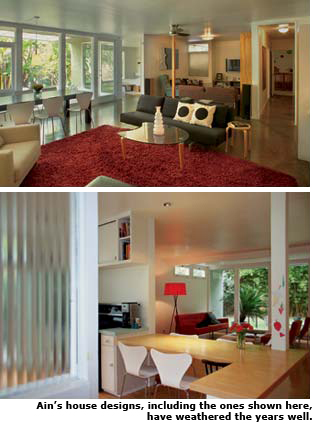The Magnificent Moderniques of Mar Vista - Los Angeles
 Hans Adamson sighs with relief whenever he returns to his neighborhood. Los Angeles is a stressful town, but not around the 'Modernique' homes in Mar Vista, where rows of street trees and broad lawns resemble a park, and the flat-roofed homes, which seem both mysterious and jaunty, clearly suggest that you are entering a place like no other.
Hans Adamson sighs with relief whenever he returns to his neighborhood. Los Angeles is a stressful town, but not around the 'Modernique' homes in Mar Vista, where rows of street trees and broad lawns resemble a park, and the flat-roofed homes, which seem both mysterious and jaunty, clearly suggest that you are entering a place like no other.
Outsiders, including architectural historian Neil Jackson, feel it as well. "It is a very special place," he confessed.
This little corner of the Mar Vista neighborhood, near Venice Beach, has been acknowledged by the city as historic. This is, after all, one of the very first tracts anywhere of modern homes, and the architect, Gregory Ain, is a modern master.
In 2003 the Modernique homes became the first postwar neighborhood in Los Angeles to receive a 'historic preservation overlay zone' (or HPOZ) to protect its historic features. Forty-nine of the original 52 homes are listed as 'contributing' to the neighborhood's character. "It is interesting that most of the fronts of these homes have never been changed," says Anni Michaelsen, who has lived in the neighborhood for 38 years. "There has to be some reason."
But beneath Mar Vista's placid surface, drama roils. The development, which was designed to be a slice of utopia, instead was troubled from the start.

Even before construction started in 1947, Ain had to compromise on some of his most deeply held beliefs by agreeing to covenants that ban home sales to blacks or Asians.
The homes were also being sold to individual buyers. The neighborhood began as a cooperative venture, with lots sold to subscribers, but there was not enough interest. Ain, who designed the homes with partners Joseph Johnson and Alfred Day, would almost certainly have preferred that they be sold as part of a cooperative housing project, such as a 280-home cooperative he had designed for Reseda, in San Fernando Valley, two years before. That project died when the Federal Housing Administration refused to finance a racially integrated neighborhood.
Ain, who was raised by Socialist parents, "really believed that he could solve some of humanity's ills through low cost housing," his daughter Emily said in a recent interview. Ain's partner on the Reseda cooperative, the accountant Robert Kahan, recalled: "Ain was determined to build nothing but cooperatives. By that time he was well known and could have done large commercial buildings, he could have been a great success. But his heart was in social housing."
Another disappointment: Mar Vista was a business failure. The project halted after only 52 homes were built. Another 48 had been planned for the two streets just up the hill. Emily attributes the failure to the FHA, which she says was reluctant to finance such odd-looking houses. Historian Esther McCoy, who was friends with Ain, blamed the neighborhood's location, near busy Venice Boulevard. And the homes were selling for $12,000, more than comparably-sized competitors.


But the neighborhood proved successful for people who bought there. Many owners have lived there for three decades or more. Pleasing customers was an Ain trait. "It is amazing how many Ain houses have weathered the years and come out looking as if they were brand new," David Gebhard and Robert Winter wrote in 'An Architectural Guidebook to Los Angeles.' "The architect must have satisfied the owners."
He certainly satisfied Michaelsen, who raised two children in her home, which remains essentially unchanged. "He was a genius designing these houses," she says. "There's no wasted space here." "The house seems larger because your eyes escape through the windows," adds her neighbor, Bonnie Jones, who has lived in the neighborhood since the 1970s. Bonnie's daughter, Barbara, also lives in a Modernique home.
Still, the drama continues. Although the neighborhood has been 'gentrifying' since the dawn of the 21st century, according to neighbor Ruth Cordish, it remains unclear exactly what changes the HPOZ allows neighbors to make to their homes. Rules that would spell out the details are still being developed—slowly. Some neighborhood meetings have grown heated. "Some people thought it was just a façade thing," says Landon Moreland, a young father who moved to the neighborhood with his family several years after the HPOZ was in place. "If you don't change the façade, you're good. But it's more than that."




